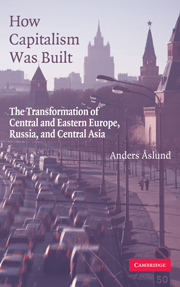Book contents
- Frontmatter
- Contents
- List of Tables and Figures
- List of Abbreviations
- Acknowledgments
- Introduction: A World Transformed
- 1 Communism and Its Demise
- 2 Shock Therapy versus Gradualism
- 3 Output: Slump and Recovery
- 4 Liberalization: The Creation of a Market Economy
- 5 From Hyperinflation to Financial Stability
- 6 Privatization: The Establishment of Private Property Rights
- 7 An Inefficient Social System
- 8 Democracy versus Authoritarianism
- 9 From Crime toward Law
- 10 The Role of Oligarchs
- 11 The Impact of the Outside World
- Conclusions: A World Transformed
- Bibliography
- Index
Introduction: A World Transformed
Published online by Cambridge University Press: 05 September 2012
- Frontmatter
- Contents
- List of Tables and Figures
- List of Abbreviations
- Acknowledgments
- Introduction: A World Transformed
- 1 Communism and Its Demise
- 2 Shock Therapy versus Gradualism
- 3 Output: Slump and Recovery
- 4 Liberalization: The Creation of a Market Economy
- 5 From Hyperinflation to Financial Stability
- 6 Privatization: The Establishment of Private Property Rights
- 7 An Inefficient Social System
- 8 Democracy versus Authoritarianism
- 9 From Crime toward Law
- 10 The Role of Oligarchs
- 11 The Impact of the Outside World
- Conclusions: A World Transformed
- Bibliography
- Index
Summary
In 1989, the Soviet bloc – from Berlin to Vladivostok – was struck by one of the greatest liberal revolutions of all times. Since then, society has changed profoundly. A complete ideological, political, economic, and social system passed away, and some 400 million people had to choose a new system. The rejection of socialism was unequivocal. A broad consensus aspired to build democracy and a market economy based on private ownership and the rule of law, and opposition to these goals was concealed in disagreement on how to accomplish them.
At the collapse of communism, liberal revolutionaries seized the political initiative. They aspired to build a “normal society” and to “return to Europe.” The petrified communist dictatorships had to give way to democracy and individual freedom, the state-controlled economy to markets, and public ownership to private property. Communism had rejected the rule of law, which should now be established. A total transformation was needed, and nobody thought it would be easy.
Communists always feared the return of capitalism. They planted many poison pills to secure the destruction of capitalism, such as the comprehensive nationalization of property, the annihilation of civil society, the elimination of markets, and the suppression of law. Communism was dead as an ideology, unable to resist the liberal revolution, but its poison pills were alive. They bred a rent-seeking state that was actually the alternative to free market capitalism.
- Type
- Chapter
- Information
- How Capitalism Was BuiltThe Transformation of Central and Eastern Europe, Russia, and Central Asia, pp. 1 - 10Publisher: Cambridge University PressPrint publication year: 2007



